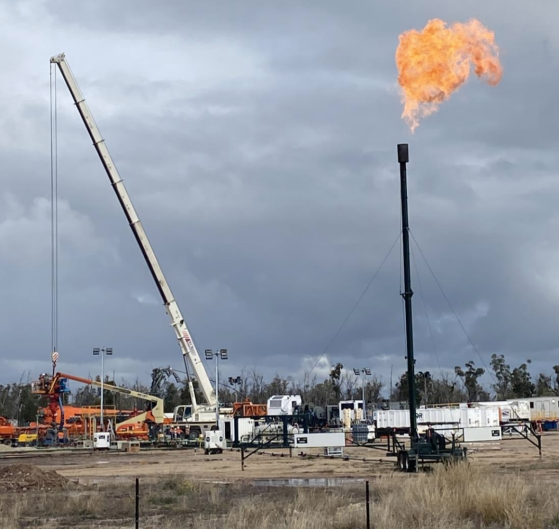Elixir Energy Ltd (ASX:EXR, OTC:ELXPF)’s belief that the Taroom Trough in Queensland’s Bowen Basin could emerge as a major new supply of Australian gas has taken a step forward. Post stimulation flow tests of the Lorelle Sandstone at the company’s Daydream-2 well at the Grandis Gas Project have delivered a potentially commercial flow-rate, with stabilised flow rates of 2.1 and 2.5 million standard cubic feet per day (MMSCFPD) achieved, plus signs that a stable flow rate of 3.0 MMSCFPD is possible.
The flow test of the Lorelle Sandstone post stimulation, completed yesterday, achieved stabilised flow rates of 2.1 and 2.5 MMSCFPD.
The Lorelle Sandstone zone was flow tested from 4,200 metres to 4,217 metres directly through the 4 1/2” casing without a completion. The well was tested at multiple rates and multiple choke sizes.
The well flowed gas at a maximum rate of 3.5 MMSCFPD and on multiple occasions stabilised rates were observed between 2.1 and 2.5 MMSCPFD throughout the flow period.
Importantly, the flow rate of the Lorelle zone, alone, is approaching the modelled economic hurdle. The company has now moved to the stimulation of the five zones above the Lorelle Sandstone.
“A massive out-performance of expectations”
Elixir managing director Neil Young said, “Achieving a potentially commercial flow-rate from only a single zone in Daydream-2 is a massive out-performance of all our expectations at the start of the well.
“There is a lot more news to come in the next few weeks and our vision that the Taroom Trough may be a major new supplier of gas to the desperately short Australian gas market – as well as the under-utilised LNG plants in Queensland – is coming close to fruition.”
Daydream-2 wellsite during Lorelle Testing operation
Economic flow rate achievable
Elixir says that as the test progressed, it became clear that stimulation fluid in the wellbore was accumulating and suppressing the stabilised rate. This issue can be resolved — significantly improving the gas production rate — by running a completion string in the hole in any future production test.
The company calculated that with the appropriate completion string in the hole, the well would flow at a stable rate of 3.0 MMSCFPD.
Given that the unstimulated rate achieved from the same zone in April 2024 was 1.3 MMSCFPD, the results of the latest flow test show that the stimulation was successful, resulting in a material increase in gas flow.
Previous modelling, as announced in April, indicated that an initial flow rate of 2.5 MMSCFPD is considered economic given the market price and relevant cost scenarios for the Grandis Project.
Gas flare of approximately 3 MMSCFPD from Daydream-2
Work ahead
On-site operations have now moved to the stimulation of the five upper zones. Elixir plans to plug, perforate and stimulate the five stages consecutively, and once that is completed in just over one week’s time, EXR will commence further flow testing.
Read more on Proactive Investors AU
